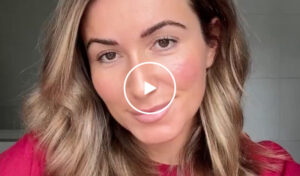Menopause has the most significant impact on a woman’s skin in her lifetime. As our hormones decrease, so too does a substantial percentage of our collagen, leading to an increase in lines, wrinkles and looser skin, as well as a number of other potential skin issues. In this ultimate guide, we address the skin changes you may notice and advise how best to prevent or treat them, so you proactively manage this transition and thrive during it, rather than feel overwhelmed!
Read on or jump to:
- What are perimenopause & menopause?
- How does your skin & hair change in menopause?
- What are the best treatments for skin in menopause?
- Does HRT help with menopausal skin changes?
- How should I look after my skin & hair in menopause?
What are perimenopause & menopause?
Perimenopause is the lesser-known of the two – it is the transitioning period marking the end of our reproductive years, when ovaries slow down the production of hormones (progesterone and estrogen) and you may start to notice physical symptoms as a result. Periods become unpredictable, irregular and eventually stop due to the decline in ovarian function. Perimenopause can last for months or years but it may not be obvious that you are perimenopausal if you only have mild or few symptoms.
Menopause literally means ‘end of monthly cycles’ i.e. is the phase in a woman’s life when her periods cease due to the marked decrease in hormone levels. You are officially considered to be in menopause when twelve consecutive months have passed since your last period. There are many potential symptoms, including hot flushes, night sweats, vaginal dryness, sleeping difficulty, low mood or anxiety, in addition to skin changes. Menopause is now a commonly discussed health topic, and given the role that oestrogen (and lack of) plays in all of our body’s systems, it is helpful to understand and manage this transition.
When do perimenopause & menopause start?
Women typically enter perimenopause in their late forties, an average of four years before actual menopause, when their reproductive organs produce fewer hormones, particularly progesterone and oestrogen. Menopause then begins officially one year after your last period (normally somewhere between 45 to 55 years) and triggers a number of key changes – not least those you notice in the mirror. Whilst symptoms vary considerably from woman to woman, there are many things you can do to help, rest assured!
How does your skin change during menopause & perimenopause?
Oestrogen affects skin’s structure as it is responsible for the production of collagen, elastin, hyaluronic acid and natural oils, all of which are essential for scaffolding and maintaining healthy and supple skin. When oestrogen levels start to decline, the effect on skin can be significant: as our stores of these essential proteins deplete, you may notice wrinkles and sagging, breakouts / acne, sensitivity, flushing, rosacea, worsening pigmentation and / or dryness.
Studies have shown that, while we start to lose collagen gradually around our 20s (about 1-2% per year), we then lose about 30% of our collagen when we enter the menopause and over the next five years or so, with a more gradual but continued decline thereafter. This significantly impacts skin and such dramatic changes can be challenging, even from our late thirties onwards, as collagen, elastin and fat start to diminish. (By contrast, collagen loss in men occurs at a constant rate).
How does your face and hair change during menopause?
You may have heard of ‘menopause face’ – not exactly a positive reference but it highlights certain changes you may notice, not just to your skin but also to your face shape (and hair). As hormone levels drop considerably, skin becomes drier, looser and thinner. You may also notice more hair on your face and less on your scalp.
Hair – the hair on your head may start to thin out (in number and thickness) and you may experience an increase in facial hair. TIP: This relates to the imbalance of oestrogen and testosterone around this age and can be helped with laser / IPL or PRP treatments.
Bones – Bone density reduces as a result of oestrogen reduction. Bone shrinkage therefore occurs in the lower jaw and chin as well as orbits (eye sockets), maxilla (upper jaw) and nose, and to the overall skull. TIP: This is an inevitable consequence of ageing but some people choose to balance this change with volumising treatments such as dermal fillers.
Fortunately, with the right care, you can lessen these effects to preserve a good sense of yourself.
What skin changes does menopause cause and what can I do?
Loss of elasticity
As collagen decreases, skin loses its elasticity, leading to a lack of firmness and changes in the shape of the face, such as the contours of the jawline and the silhouette of the nose.
TIP: Collagen is made of three polypeptide chains, so using a product that contains peptides can stimulate your skin to make more collagen. Retinol products can be hugely effective too – when applied to the skin, converting into retinoic acid which makes changes at a cellular level, increasing skin cell turnover, and stimulating collagen and elastin. A wide range of non-surgical aesthetic treatments is also available, to help lift and tighten loose ageing skin, including radiofrequency, skin needling, and dermal fillers.
Fine lines and wrinkles
Depletion of elastin, as well as collagen, is also a contributing factor in the development of fine lines and wrinkles. Wrinkles that used to appear only with a smile or frown may become visible all the time, and deeper lines may form from the nose to the corners of the mouth.
TIP: Protecting your skin from the sun is the most important thing to do in the first instance, and can reduce visible wrinkles as well as prevent new ones. Specialised treatments target fine lines and wrinkles, including wrinkle-relaxing injections, skin boosters, HydraFacial and EndyMedPro 3DEEP.
Redness and irritated skin
Changes to the pH level of our skin during menopause may lead to changes in its sensitivity. Women are more likely to develop rashes and easily irritated skin during menopause and those with an existing skin condition, such as eczema or rosacea, may find these worsen.
TIP: If you experience increased sensitivity of the skin, consider moving to fragrance-free products, and also keep a skin diary to try to ascertain any ingredients that may be contributing to irritation. Photorejuvenation treatments, such as Formatk IPL [link], use the latest technology to treat concerns such as facial redness and rosacea. Additionally, performing the treatment stimulates collagen production.
Dry skin
In menopause, skin loses some of its ability to retain moisture, which in turn leads to dryness. This is particularly problematic if you live in a dry climate, and / or have your central heating or air conditioning on.
TIP: Consider using a mild cleanser instead of soap, since some of the active ingredients in most soaps and foaming products can irritate and dry out skin. Choosing a moisturiser that contains ceramides and hyaluronic acid is important since it plays a crucial role in dermal health, regulating cell growth and hydration. We are born with a certain amount of hyaluronic acid and our bodies do not produce more as we age, so you might like to consider harnessing the restorative powers of hyaluronic acid through hydrating aesthetic treatments and facial fillers instead.
We recommend you address the collagen loss that occurs during menopause by stimulating oestrogen receptors within facial skin. Try ASM Collagen Activation Duo (Regenerating Ampoules and Replenishing Cream) as an optimum combination to kick start your collagen production at source. Specialised growth factors also enhance cellular communication, helping to increase collagen, elastin, hyaluronic acid levels. This potent combination is clinically proven to increase firmness, deeply hydrate and improve the appearance of lines and wrinkles by up to 50%.
Blemishes and acne
Hormonal changes are often at the root of blemishes and acne, so it follows that these skin concerns can occur during menopause, as hormone production drops. As skin is likely to be thinner and drier during menopause, though, the treatments used for teenage acne are usually too harsh and can even worsen acne.
TIP: Salicylic acid helps the skin to shed dead cells and reduces redness and swelling, so this is a good active ingredient to include in your skincare routine.
We recommend you speak to a professional (such as an aesthetic doctor or dermatologist) to ascertain what is causing your breakouts. Skincare containing a retinoid may also be helpful to unclog pores and an effective cleansing product like ZO’s Exfoliating Cleanser can be very good for blemishes (although may be too strong for sensitive or rosacea-prone skin, hence you should talk to an expert for advice).
Brown spots
Hormone–related pigmentation can worsen during perimenopause and menopause. Sun protection – and avoidance! – are key. A doctor can also prescribe specialist creams to help manage discolouration and improve skin tone.
TIP: We recommend you have a consultation with an aesthetic doctor if brown spots are a particular concern for you. They will advise the most appropriate options for you and may discuss an active ingredient known as Hydroquinone which is prescription-strength.
Vaginal atrophy
Oestrogen and collagen reduction affects all tissues, including areas you’d not necessarily expect, for example causing vaginal atrophy (atrophic vaginitis) – the thinning, drying and inflammation of the vaginal walls. This can be distressing and trigger significant symptoms such as dryness, burning, itching and recurrent urine infections.
TIP: We recommend a low-dose oestrogen–based gel or cream to help relieve discomfort. Again, these are available on prescription so would be discussed with a doctor / consultant if you would like to seek help.
What are common skin conditions in menopause?
It is common to develop redness, irritated, dry or sensitive skin during menopause, as well as brown spots. You may also be more prone to bruising or notice that existing skin conditions flare up during this time. You may experience:
- Acne
- Dermatitis
- Rosacea
- Psoriasis
Some women develop Haxthausen disease (keratoderma climactericum) during menopause – a serious-sounding name for what is, fortunately, a harmless skin condition, causing thickening of the soles of the feet.
How common are skin changes during menopause?
Skin changes at this time are very common – almost all women will notice some changes to their skin during perimenopause and menopause.
What are the more unusual skin sensations in menopause?
Altered skin sensation is a lesser known potential symptom of menopause. You may experience a loss of sensation / numbness, pins & needles, prickling, itchy skin or burning in your hands or feet. Some women experience formication: a sensation of insects crawling over the skin.
How does menopause affect your oral health, mouth and jawline?
Be extra mindful of your oral health and lower face during menopause. As bone mass and collagen reduces, teeth are more likely to become looser and sensitive. You may experience a dry or burning mouth and there is an increased risk of gum disease and gingivitis. Some women also find they grind their teeth, probably due to the disturbed sleep which commonly occurs at this age. You may also notice your lips are a little thinner. Dental checkups are therefore key, as is good dental hygiene. An aesthetic doctor can help with lip thinning if you prefer fuller lips.
What are the best treatments for menopausal skin?
There are numerous gold-standard, clinically proven treatments to tackle the dryness, irritation, lines and wrinkles and hormonal breakouts associated with menopause. A professional will advise treatments and skincare which effectively and specifically target whichever issues your skin experiences (such as lines around the eyes and mouth, sagging skin, loss of definition and thinning lips). Options include radiofrequency, micro-needling, skin boosters, and anti-wrinkle injections, dermal fillers and chemical peels, as well as skincare to target your specific skin symptoms.
How can I look after my skin during menopause?
A few simple steps will ensure you take optimum care of your skin and will also help overall skin ageing:
- Find a cleanser that works for your skin type
- Repair your skin barrier function with a nourishing moisturiser
- Manage acne with salicylic acid and retinoids
How can I improve the signs of skin ageing after menopause?
Skincare containing growth factors can awaken sleeping skin cells, promoting regeneration and repair. You can purchase these from the high street or, if you’d prefer a more potent form, opt for professional skincare and advice from an aesthetic professional in a clinic. We like Allskin Med’s Regenerating Ampoules.
How can I tighten my skin after menopause?
Skin sagging can be one of the most frustrating symptoms of ageing and menopause so you may like to investigate treatments such as EndyMed Intensif – a combination of radio-frequency and micro needling, designed to improve skin texture and trigger skin’s natural healing, resulting in a firming effect. For topical skincare at home, try growth factor-based serums. You might also like to read further about improving skin elasticity
How does HRT affect skin? Will it make me look younger / reverse skin ageing?
You may find hormonal treatments helpful in retaining a more youthful complexion. Hormone replacement therapy (HRT) has been shown to increase epidermal hydration, skin elasticity, skin thickness (Sator et al 2001), and also reduces skin wrinkles. You may have also heard of BHRT (Bio-identical Hormone Replacement Therapy) which, used in conjunction with skin rejuvenation treatments, can help combat or prevent concerns associated with menopause. BHRT is a more natural (plant-based) version of traditional HRT and can be prescribed in the form of creams, tablets or lozenges to help balance hormone levels.
How do I request hormone replacement therapy?
You need a consultation with a doctor who specialises in hormones / menopause to discuss your symptoms with. She / he will then order blood tests to determine next steps and what is most appropriate, for example prescribing HRT or BHRT for you.
How long does it take for HRT to improve skin?
Typically, you would expect to notice an increase in skin hydration and elasticity, as well as an improvement in lines and wrinkles, after approximately 6 months’ use of BHRT / HRT.
However, during this major transition in hormones, there are constant fluctuations and so in-clinic treatments such as skin booster, Profhilo, may be a helpful addition, as well as an at–home skincare regime specific to your particular skin type and concerns.
What are the best skincare ingredients for menopausal skin?
Speak to a skincare professional about what would suit your skin needs specifically. You will be recommended skincare which contains targeted ingredients like:
- Hyaluronic acid
- Ceramides
- Niacinamide
- Retinoids (these can irritate so start gradually)
- Growth factors
- Vitamin C
- AHAs (alpha hydroxy acids)
Checklist to look after your skin during perimenopause & menopause
- Keep a diary of skin changes
- Speak to a professional for advice about your specific skin
- Adapt your skincare regime to suit (avoid irritants such as fragrance, aim to hydrate as needed)
- Avoid other collagen-loss triggers such as caffeine, smoking, UV light & pollution. Wear a broad-spectrum sunscreen with anti-oxidant protection
- Research oestrogen-boosting treatments – from BHRT to nutrition
- Eat mindfully – stick to good nutrition principles and avoid alcohol & trigger foods
- Follow a healthy lifestyle – regular exercise, plenty of sleep, mindfulness / CBT
- Manage hot flushes & night sweats – natural fibres, clothing layers, avoid triggers, carry a fan, maintain a healthy weight, explore mind–body practices
- Avoid scratching (wear breathable silk gloves at night if necessary)
- Turn down heating / air con
- Seek help from a medical professional as necessary
Conclusion
The sudden skin changes associated with menopause can be really frustrating at this comparatively young age – you’d like your face to reflect how youthful you are! Monitor how your skin is changing and adapt your skincare regime to suit, complementing it with treatments if you need / can – the key is to retain as much collagen as you can, and / or boost your remaining collagen stores. Also maintain a healthy lifestyle to help you thrive overall.
Do your research to find a medically-trained aesthetic team or skincare professional who takes a positive approach to menopause – it’s important to be looked after by someone who appreciates how maintaining a youthful appearance can go a long way to ensuring you feel good, not least as you may be managing difficult physical symptoms. The sooner you get to work on your skin the better, to retain and boost as much of your collagen as possible. If you have a consultation with a menopause expert, such as Dr Paris, you’ll discuss your medical history, lifestyle and any particular concerns, and then have a clear treatment plan so you once again have a glowing, hydrated and youthful complexion.






